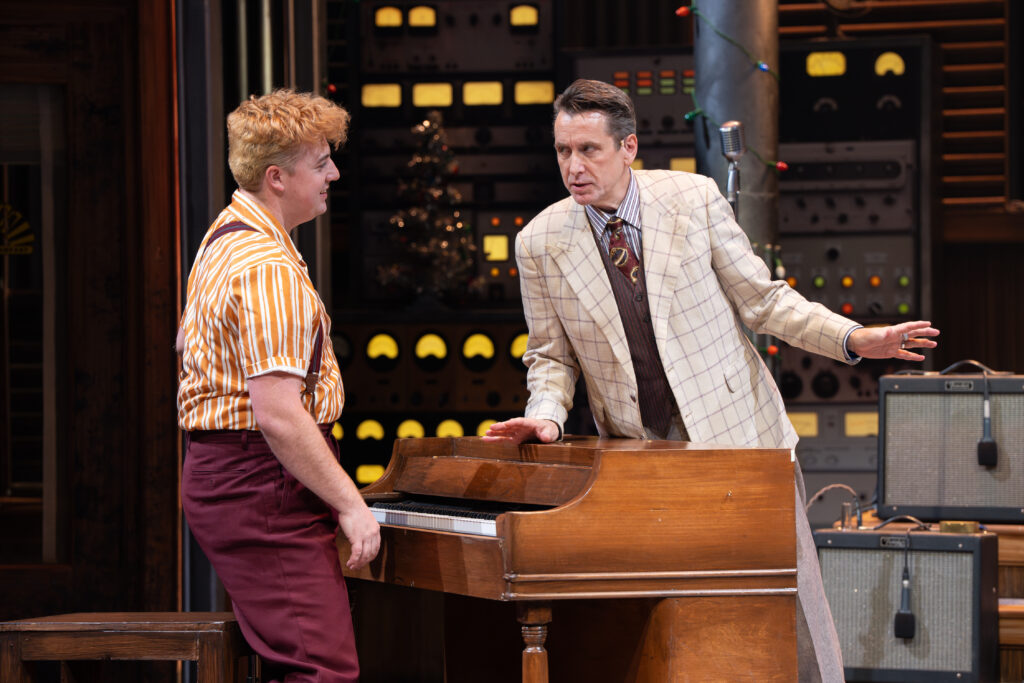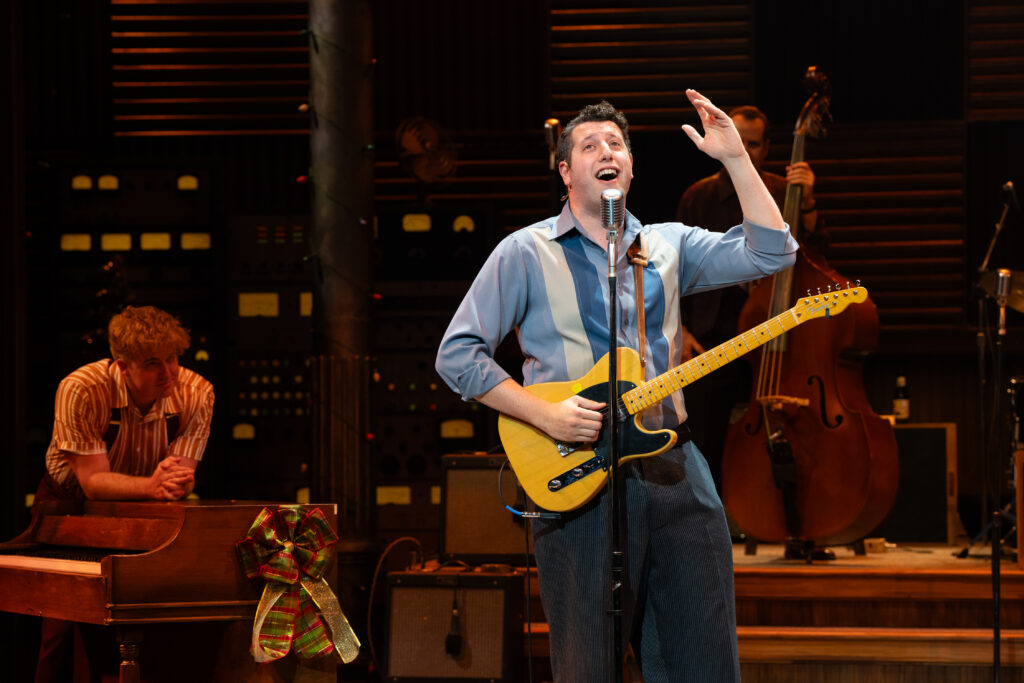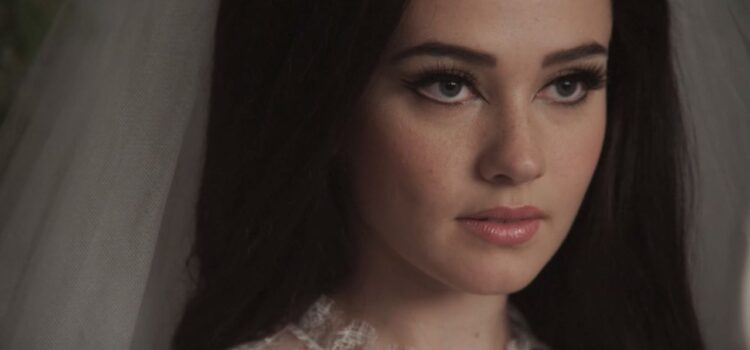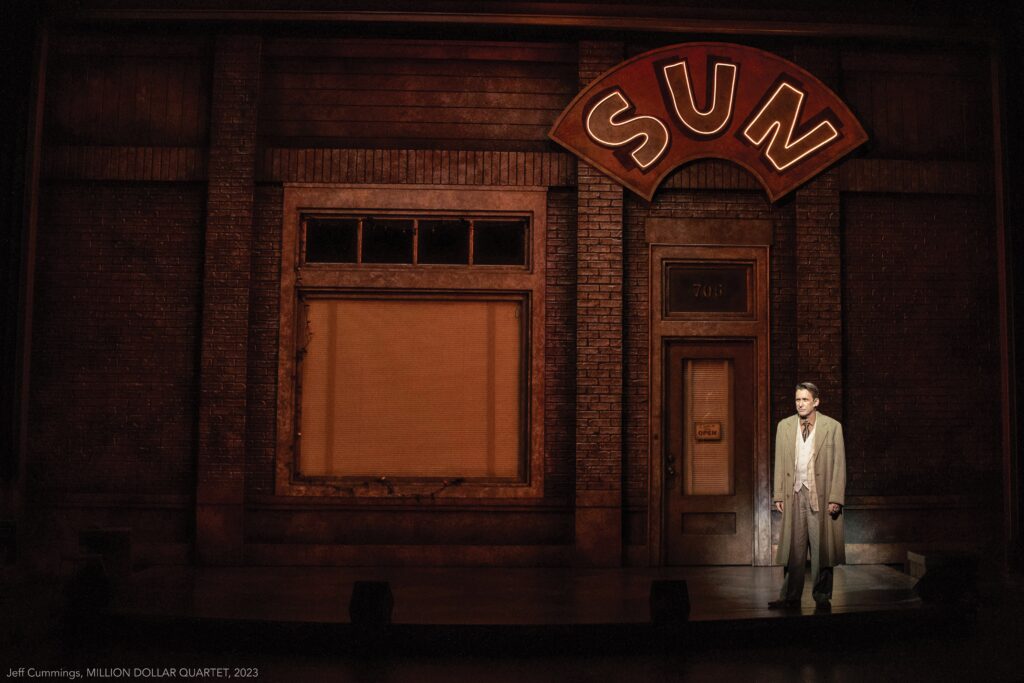By Lynn Venhaus
Without skipping a beat, four iconic music legends continue a sentimental reunion in the cheery holiday show “Million Dollar Quartet Christmas,” which has been gift-wrapped with star power and delightful musicality.
On Dec. 4, 1956, Johnny Cash, Carl Perkins, Elvis Presley, and newcomer Jerry Lee Lewis gathered at the Sun Records studio in Memphis, all at different stages of their careers, and jammed the night away – for the first and only time.
That twist of fate was captured in an enchanting jukebox musical “Million Dollar Quartet” that highlighted the enduring rhythm of roots rock. It was first produced in Florida in 2006, then Chicago in 2008, and eventually on Broadway in 2010, and the nostalgic charmer was nominated for three Tony Awards
This 2021 sequel version is a festive and fun presentation that builds on the original premise, which were both smash hits at The Repertory Theatre of St. Louis in 2017 and at Stages St. Louis in 2023.
In a savvy move, the two companies have collaborated to bring this crowd-pleasing show to life with many of the same artists involved in the Stages production but presented on The Rep’s mainstage. This is the first partnership, but hopefully not the last.

The memorable trio of Scott Moreau duplicating Johnny Cash’s deep bass-baritone, Jeremy Sevelovitz as fast-playing honky-tonk specialist Carl Perkins and Brady Wease as sparkplug Jerry Lee Lewis easily blend with suave newcomer Sean Buckley, whose graceful moves capture Elvis Presley’s vitality.
What a jolly time it is to see this cast perform together. Crackling with electricity, these other fabulous, fantastic four guys create a warmth onstage, even if they needle each other.
Their energy is limitless, and their showmanship stellar. While it is a blissful blast from the past, it’s not just the Christmas songbook’s greatest hits. They dip into their rockabilly classics – those fusions of country and rhythm and blues they became known for – but present fresh takes on holiday classics like “Jingle Bell Rock,” “I’ll Be Home for Christmas,” and “God Rest Ye Merry Gentlemen.”
Everyone expects “Blue Christmas,” of course, and Buckley delivers a dandy one. Upbeat highlights include Chuck Berry’s “Run Rudolph Run,” the Bing Crosby cover “Mele Kalikimaka” and “Boogie Woogie Santa Claus.”
The statuesque Shelby Ringdahl is back as Elvis’ girlfriend Dyanne, and so is Jeff Cummings as impresario Sam Phillips. The dynamic duo of music director Dave Sonneborn as W.S. “Fluke” Holland on drums and Chuck Zayas as Jay Perkins on bass, one of the original cast members, have returned.

It’s obvious this entire group of seasoned professionals are a tight team that enjoys spending time together – and wow, can they rock around the Christmas tree. With their slick musicianship, there is a whole lotta shakin’ going on.
Colin Escott’s script, while formulaic, focuses on the heart and the humor, and because the group feels so familiar with each other, they smooth over the rough edges.
As the guys reminisce about their humble beginnings, they tell Christmas tales tied to their Southern roots. They admit struggling to fit into a cutthroat show business when people don’t understand their blue-collar cultural upbringing.
The men are at a crossroads, some having tasted more success than the others. They got their start through Phillips, aka “The Father of Rock ‘n Roll,” whose personal feelings are hurt because of the professional transactions. He’s too much of a country boy to be considered a main player by the big-city record companies.
After putting Sun Records on the map, Elvis received a huge record contract with RCA Records, while Johnny and Carl recently moved on to Columbia. The brash Jerry Lee is pegged as Phillips’ next big thing.
As played by the high-spirited Wease, swaggering Lewis is full of braggadocio, easily getting on everyone’s nerves. Yet, his pounding of the piano keys is always a high point.

There is a wistfulness that you sense among the three older ones. Elvis expresses a homesick blues, though, while Cash and Perkins are making wishful new plans. That adds a relatable poignancy as people tend to reflect on the year past at holiday time and look ahead to a more promising future.
Dyanne’s role is stronger this go-round, and Ringdahl dances merrily while joining the guys. At the real session, Elvis brought Marilyn Evans, now Riehl, who was a dancer. Ringdahl delivers a playful “Santa Baby.”
Director Keith Andrews focuses on the opportunity for magical moments – because it is the most wonderful time of the year. He has previously directed the original six times, so he is quite familiar with this material.
The precise craftsmanship of scenic designer Adam Koch is noteworthy for decking the halls with bright lights, mistletoe, tinsel and a tree, all bathed in a beautiful glow by lighting designer Sean M. Savoie. And sound designer Beef Gratz’ work is crisp and clear.
Costume designer Brad Musgrove has outfitted everyone in 1950s winter garb, plus woven in sequins for another killer grand finale. He selected a knockout red cocktail dress for Dyanne, while wig designer Dennis Milam Bensie coiffed her chicly.

A special shout-out to those who dressed the theater in style, transforming the lobby and outside into a breathtaking winter wonderland.
The stars shined brightly, and the cast’s harmony embossed this celebration of comfort and joy with wonderful verve. “Million Dollar Quartet” is a two-hour sentimental journey that sparks warm memories, reaffirms music’s deep connection in our lives, and allows our hearts to be light.
In partnership with Stages St. Louis, the Repertory Theatre of St. Louis presents the musical “Million Dollar Quartet Christmas” Dec. 4 – 22. Performances take place on the main stage of the Loretto-Hilton Center on the Webster University campus. For more information: www.repstl.org.

Lynn (Zipfel) Venhaus has had a continuous byline in St. Louis metro region publications since 1978. She writes features and news for Belleville News-Democrat and contributes to St. Louis magazine and other publications.
She is a Rotten Tomatoes-approved film critic, currently reviews films for Webster-Kirkwood Times and KTRS Radio, covers entertainment for PopLifeSTL.com and co-hosts podcast PopLifeSTL.com…Presents.
She is a member of Critics Choice Association, where she serves on the women’s and marketing committees; Alliance of Women Film Journalists; and on the board of the St. Louis Film Critics Association. She is a founding and board member of the St. Louis Theater Circle.
She is retired from teaching journalism/media as an adjunct college instructor.





















